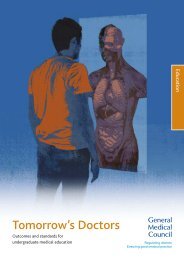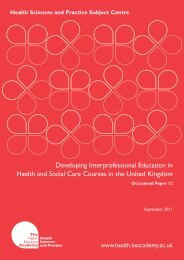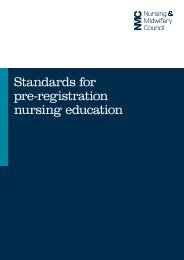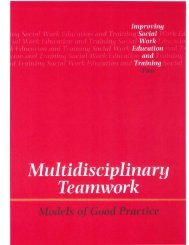(WHO) Patient Safety Curriculum Guide - CAIPE
(WHO) Patient Safety Curriculum Guide - CAIPE
(WHO) Patient Safety Curriculum Guide - CAIPE
Create successful ePaper yourself
Turn your PDF publications into a flip-book with our unique Google optimized e-Paper software.
Rationale for each <strong>Curriculum</strong><br />
<strong>Guide</strong> topic<br />
Health-care professionals who teach students<br />
may not immediately appreciate why certain<br />
topics are included in this <strong>Curriculum</strong>. They may<br />
already be teaching a particular topic, but have<br />
not categorized it as patient safety. Teachers<br />
may also discover that many of the principles<br />
and concepts addressed in this <strong>Curriculum</strong> are<br />
similar to existing educational material, but with<br />
a different emphasis. The significance of each<br />
topic in the learning of health-care students<br />
is clarified below.<br />
Topic 1: What is patient safety?<br />
Given that health-care professionals are<br />
increasingly being required to incorporate patient<br />
safety principles and concepts into everyday<br />
practice, this topic presents the case for patient<br />
safety. In 2002, <strong>WHO</strong> Member States agreed<br />
on a World Health Assembly resolution on patient<br />
safety in recognition of the need to reduce the<br />
harm and suffering of patients and their families,<br />
as well as the compelling evidence of the<br />
economic benefits of improving patient safety.<br />
Studies show that additional hospitalization,<br />
litigation costs, health care-associated infections,<br />
lost income, disability, and medical expenses<br />
cost some countries between US$ 6 billion and<br />
US$ 29 billion a year [3, 4].<br />
A number of countries have published studies<br />
highlighting the overwhelming evidence showing<br />
that significant numbers of patients are harmed<br />
due to their health care, either resulting in<br />
permanent injury, increased length of stay (LOS)<br />
in health-care facilities, or even death. We have<br />
learnt over the last decade that adverse events<br />
occur not because people intentionally hurt<br />
patients. They are, rather, due to the complexity<br />
of today’s health-care systems, especially in<br />
developed countries, where the successful<br />
treatment and outcome for each patient depend<br />
on a range of factors and not just the competence<br />
of one individual health-care provider. When<br />
so many different types of health-care providers<br />
(doctors, nurses, pharmacists and allied healthcare<br />
workers) are involved, it is very difficult<br />
to ensure safe care unless the system of care<br />
is designed to facilitate timely and complete<br />
information and understanding by all the health<br />
professionals.<br />
Similarly, in developing countries, a combination<br />
of numerous unfavourable factors such as<br />
understaffing, inadequate structures and<br />
overcrowding, lack of health-care commodities<br />
and shortage of basic equipment, poor hygiene<br />
and sanitation, all of which can be attributed<br />
to limited financial resources, contribute to unsafe<br />
patient care.<br />
Topic 2: Why applying human factors<br />
is important for patient safety<br />
Human factors is an area of expertise of engineers<br />
and cognitive psychologists. This topic may<br />
provide some challenges for health professional<br />
faculty as well as students. We recommend that<br />
you invite an appropriate person with human<br />
factors expertise to give a lecture to the students.<br />
Human factors, engineering or ergonomics is the<br />
science of the interrelationship between humans,<br />
their tools and the environment in which they<br />
live and work [4]. Human factors engineering will<br />
help students understand how people perform<br />
under different circumstances so that systems<br />
and products can be built to enhance performance.<br />
It covers the human-machine and human-tohuman<br />
interactions such as communication,<br />
teamwork and organizational culture.<br />
Other industries such as aviation, manufacturing<br />
and the military have successfully applied<br />
knowledge of human factors to improve systems<br />
and services. Students need to understand<br />
how human factors can be used to reduce<br />
adverse events and errors by identifying how<br />
and why systems break down and how and<br />
why human beings miscommunicate. Using<br />
a human factors approach, the human-system<br />
interface can be improved by providing<br />
better-designed systems and processes.<br />
This often involves simplifying processes,<br />
standardizing procedures, providing backup<br />
when humans fail, improving communication,<br />
redesigning equipment and engendering<br />
a consciousness of behavioural, organizational<br />
and technological limitations that lead to error.<br />
Topic 3: Understanding systems and<br />
the effect of complexity on patient care<br />
Students are introduced to the concept<br />
that a health-care system is not one, but many<br />
systems made up of organizations, departments,<br />
units, services and practices. The huge number<br />
of relationships between patients, carers,<br />
health-care providers, support staff,<br />
administrators, economists and community<br />
members, as well as the relationships between<br />
the various health-care and non-health-care<br />
services, add to this complexity. This topic<br />
gives students a basic understanding of<br />
complex organizations using a systems approach.<br />
Lessons from other industries are used<br />
to show students the benefits of a systems<br />
approach.<br />
29 Part A 2. How were the <strong>Curriculum</strong> <strong>Guide</strong> topics selected?













